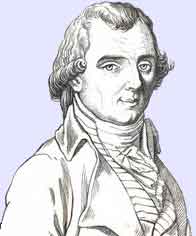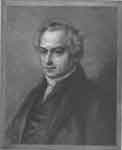- Relativity FAQ about Olbers' paradox
- Astronomy FAQ about Olbers' paradox
- Cosmology FAQ about Olbers' paradox
- Paul Wesson, "Olbers' paradox and the spectral intensity of the extragalactic background light", The Astrophysical Journal 367, pp. 399-406 (1991).
- Edward Harrison, Darkness at Night: A Riddle of the Universe, Harvard University Press, 1987
- Scott, Douglas, and Martin White, "The Cosmic Microwave Background".
.
Heinrich Wilhelm Olbers

Heinrich Wilhelm Olbers.
Heinrich Wilhelm Matthäus Olbers (October 11, 1758 March 2, 1840) was a German astronomer, physician and physicist.
He was born in Arbergen, and studied to be a physician at Göttingen. After his graduation in 1780, he began practicing medicine in Bremen, Germany. At night he dedicated his time to astronomical observation.
| 2 Pallas | March 28, 1802 |
| 4 Vesta | March 29, 1807 |
In 1802, Olbers discovered (and named) the asteroid Pallas. In 1807 he discovered the asteroid Vesta, which he allowed Gauss to name.
On March 6, 1815, Olbers also discovered a periodic comet named after him (formally designated 13P/Olbers).
He died in Bremen.
Olbers' paradox is named after him described earlier by Johannes Kepler in 1610 and Halley and Cheseaux in the 18th century, is the paradoxical statement that in a static infinite universe the night sky should be bright. This is sometimes also known as the "dark night sky paradox".
Assumptions
If the universe is assumed to be infinite, containing an infinite number of uniformly distributed luminous stars, then every line of sight should terminate eventually on the surface of a star. The brightness of a surface is independent of its distance, so every point in the sky should be as bright as the surface of a star.
For stars to appear "uniformly distributed" in space they must also be uniformly distributed in time, because the further away one looks, the older is what one sees. On an infinite scale, this means the universe must be infinitely old with no dramatic changes in the nature of stars in that time.
Kepler saw this as an argument for a finite universe, or at least for a finite number of stars, but the argument is not convincing, as will be shown below.
Explanations
One explanation attempt is that the universe is not transparent, and the light from distant stars is blocked by intermediate dark stars or absorbed by dust or gas, so that there is a bound on the distance from which light can reach the observer. However, this reasoning does not resolve the paradox. According to the first law of thermodynamics, energy must be conserved, so the intermediate matter would heat up and soon reradiate the energy (possibly at different wavelengths). This would again result in uniform radiation from all directions, which is not observed.
The explanation of the paradox to gain the most scientific consensus points to the finite speed at which light travels through space. Given its finite speed, the light from the most distant star cannot have travelled a further distance, measured in light years, than the star itself is old. This explanation was first offered in 1848 by poet and writer Edgar Allan Poe, who observed:
"Were the succession of stars endless, then the background of the sky would present us an uniform luminosity, like that displayed by the Galaxy -–since there could be absolutely no point, in all that background, at which would not exist a star. The only mode, therefore, in which, under such a state of affairs, we could comprehend the voids which our telescopes find in innumerable directions, would be by supposing the distance of the invisible background so immense that no ray from it has yet been able to reach us at all."[1]
Holding the universe to be approximately 15 billion years old, the furthest expanse that light could have possibly travelled since its creation is an equal number of light years. Thus, even if every infinite trajectory into space from the earth eventually passes through a star in the farthest regions of the universe, the light of all such stars beyond the maximum distance in which light has travelled since the origin of the universe will remain beyond visibility from earth.
Resolutions
The paradox is resolvable in a variety of ways.
If the universe has existed for only a finite amount of time, as the prevalent Big Bang theory holds, then only the light of finitely many stars has had a chance to reach us yet, and the paradox breaks down. Alternatively, if the universe is expanding and distant stars are receding from us (also a claim of the Big Bang theory), then their light is redshifted which diminishes their brightness, again resolving the paradox. Either effect alone would resolve the paradox, but according to the Big Bang theory, both are working together; the finiteness of time is the more important effect. Some see the darkness of the night sky to be evidence in support of the Big Bang theory.
Even without the Big Bang theory and its redshift evidence, we may establish the finite age of the universe (in its present form) by a mathematical evaluation of hydrogen. Assume that the amount of mass in stars divided by the total amount of mass in the universe is nonzero. After some length of time, any given star will convert too much hydrogen into helium (or heavier elements) to continue nuclear fusion. From this we conclude that in unit time, the amount of hydrogen converted into helium by a given star divided by the star's mass is nonzero. Combining this with the earlier statement, we conclude that the amount of hydrogen converted into helium by stars as a whole divided by the mass of the universe is nonzero. There is no known process that can return heavier elements to hydrogen in the necessary quantities, and any would probably violate the second law of thermodynamics. Therefore, the amount of time needed for stars to convert all of the hydrogen in the universe into helium is finite, and it will never change back. After this, only heavier-element-burning stars will exist (and these will die when they hit iron, an event known as the heat death of the universe). This hasn't happened yet, so either the universe is of finite age, it has undergone major changes in its history, or there exists some highly exotic process (for which no direct evidence exists) that produces hydrogen to keep it going.
A different resolution, which does not rely on the Big Bang theory, was offered by Benoit Mandelbrot. It holds that the stars in the universe may not be uniformly distributed, but rather fractally like a Cantor dust, thus accounting for large dark areas. It is currently not known whether this is true or not, although recent satellite studies have found the cosmic microwave background radiation is isotropic to 1 part in 10000.
References
Honors
The following celestial features are named for him:
Asteroid 1002 Olbersia.
Olbers crater on the Moon.
Retrieved from "http://en.wikipedia.org/"
All text is available under the terms of the GNU Free Documentation License


